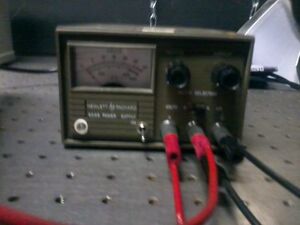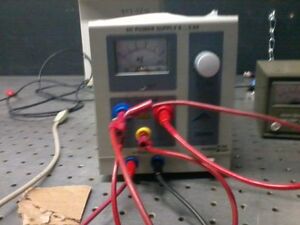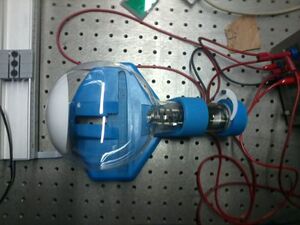User:Nathan Giannini/Notebook/Physics 307L/101205
Steve Koch 20:24, 21 December 2010 (EST): Good primary lab notebook. My lab partner for this experiment is Richard T. Meyers

Procedure

Besides the procedure found in this Lab Manual we mainly adjusted the voltage and took measurements. A wiring diagram can be found here. We decided not to use the bias source, since we found that once it was turned on we would lose all visibility for our rings.
Equipment
- Carrera Precision 6 inch digital caliper alloy # CP8806-T
- DC Power Supply 0-5 kV 3B U33010 6.3V AC/3A
- HP6216B Power Supply
- Electron Diffraction Bulb 5kV .3mA 3B 0185712309003
Safety
The 5kV voltage source presents a significant shock hazard, as touching the casing of our source will give you an electric shock. Also, do not let heater overheat the graphite. The graphite will glow dull red if it is.
Set-Up
Main set-up can be found in the lab manual above. Otherwise, make sure all banana wires are connected to the right terminals, turn on both power supplies, turn the voltage up to 5kV for the main source, and center the rings using the magnet.
Data

The data below is the raw data.
Electron Diffraction(mine) XL Doc
The Line is the fit for my charts.






Calculations
Along with the equations given in the book, Kirstin offered a correction for our rings.
[math]\displaystyle{ y=R-\sqrt{R^2-\frac{D_{observed}^2}{4}}\,\! }[/math]
[math]\displaystyle{ tan(\theta)=\frac\frac{D_{observed}}{2}{L-y}\,\! }[/math]
[math]\displaystyle{ D_{corrected}=2Ltan(\theta)\,\! }[/math]
With the corrected diameters I was able to calculate the [math]\displaystyle{ d }[/math] using the following equations:
[math]\displaystyle{ d=\frac{2hLc}{{D}\sqrt{2eV_{accelerated}c^2}}=\frac{2hL}{{D}\sqrt{2eV_{accelerated}}}\,\! }[/math]
further this becomes:
[math]\displaystyle{ d=\frac\frac{2hL}{\sqrt{2me}}{slope}\,\! }[/math]
I ended up getting:
- Inner Ring:
- [math]\displaystyle{ d=0.267(7)nm\,\! }[/math]
- Outer Ring:
- [math]\displaystyle{ d=0.174(6)nm\,\! }[/math]
Sadly, the currently accepted values are 0.213nm and 0.123nm. This means that my Inner Ring value is off by ~9SEM and my Outer Ring value is off by ~10SEM. I will evaluate this in my summary located here